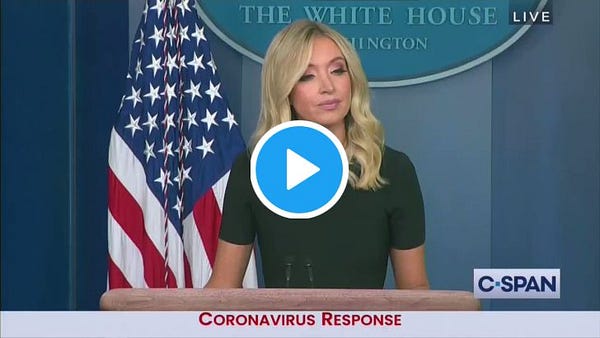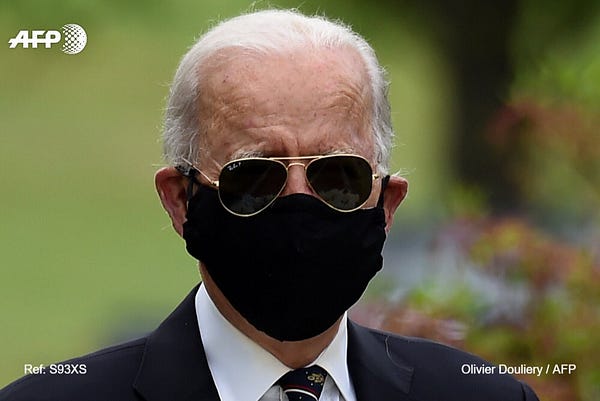
1. Masks
For the last half year Joe Biden has been both preaching and practicing a commonsense approach to safety and public health.
And for this, Biden was mocked by Donald Trump and his partisans.
I want to pause for a minute to remind you how stupid—aggressively, perniciously stupid—Trump and his enablers have been on this point. Let’s take a brief tour.
There was True Conservative Matt Schlapp.


There was Don’s Big Boy Mike Huckabee:
The fact is, he prided himself on wearing a mask the other day at the memorial ceremony. The truth is, that was not a mask, Sean, that was a gag. His staff put it on him to keep him from saying something that they would spend the next three days walking back.
There was Brit Hume, who is smart enough to know better.
There were the click-whores at the Federalist, who are not smart enough to know better.

There was moral paragon Jason Miller.

There was Kayleigh McEnany, the most honest press secretary in the history of the White House.


And, of course, there was President Trump doing it again:
"But did you ever see a man that likes a mask as much as him?" Trump asked a crowd in Pennsylvania earlier this month of Biden. "And then he makes a speech, and he always has it—not always, but a lot of times, he has it hanging down. Because, you know what, it gives him a feeling of security. If I were a psychiatrist—right? I'd say, this guy's got some big issues. Hanging down."
And again:
Wallace: President Trump, you have begun to increasingly question the effectiveness of masks as a disease preventer. And in fact, recently you have cited the issue of -- of waiters touching their masks and touching plates. Are you questioning the efficacy of masks?
Trump: No, I think that masks are OK. You have to understand, if you look -- I mean, I have a mask right here. I put a mask on, you know, when I think I need it.
Tonight, as an example, everybody's had a test and you've had social distancing and all of the things that you have to, but—
Biden: Just like your rallies.
Trump: —I wear masks when needed. When needed, I wear masks.
Wallace: OK, let me ask --
Trump: I don't have -- I don't wear masks like him. Every time you see him, he's got a mask. He could be speaking 200 feet away from them and he shows up with the biggest mask I've ever seen.
The president of the United States now has COVID-19.
Joe Biden does not.
So tell me Rich, where does Joe Biden go to get his apology?
2. The Truth About Masks
There is a sizable contingent of Americans—close to 15 percent—who refuse to wear masks even in close-contact indoor settings.
I can’t tell you why this is. Most of these people are, just by the numbers, self-identified Republicans. Maybe it’s stupidity. Maybe it’s in-group peer pressure. Maybe it’s tribal signaling.
What I can tell you is that this behavior is madness.
You don’t have to wear masks all the time for everything. I’ve written about this a lot, but in case you want a refresher:
You can’t really understand masks unless you know a little bit about virology and a little bit about fluid dynamics.
On the virology front, you don’t get sick from intaking a single virus particle. You need to take in an infectious dose sufficient to allow the bug to overwhelm your body’s defenses and get a foothold within your system. . . .
Which brings us to the viral load: That’s the number of virus particles floating around in a person’s system once they have the bug. For respiratory diseases in general, the higher your viral load is, the more virus particles you’re going to shed when you cough, sneeze, or exhale.
So far, so good. Now the fluid dynamics. . . .
When you cough or sneeze or breathe, the virus particles aren’t being expelled as pure particles—they’re suspended in your fluids, which become aerosolized. . . .
A mask isn’t going to filter out virus particles. That’s what respirators are for. The design purpose of the mask is to retard the spread of aerosolized droplets which carry virus particles. The mask either blocks these droplets entirely (if they are large) or slows their exit velocity (if they are small) so that gravity brings the droplets to ground at a shorter distance, reducing their physical spread.
Using just this basic understanding of how infection works, it’s not hard to come up with commonsense use-case guidelines:
You’re out walking and passing other people occasionally: You don’t need to wear a mask.
You’re gardening and your neighbor pops into your yard to chat for a minute while standing 6 feet away: You don’t need to wear a mask.
You’re sitting next to your spouse on a zoom call: You don’t need to wear a mask.
On the other hand:
You’re sitting in an auditorium with 40 people watching a movie for 2 hours: Wear a mask.
You’re in a classroom with a number of children/teachers for several hours: Wear a mask.
You’re in an office with several other adults for a prolonged period of time: Wear a mask.
And for the love of God, if you’re ass-to-elbows with 300 people for more than an hour—even if you’re outside—like this:

WEAR A FORKING MASK.
Or better yet, wear a respirator, either of the N95 or KN95 or FFP2 variety. They’re not hard to get hold of anymore.
Every time I look at that picture, it makes me viscerally angry because I cannot understand for the life of me why every single person there isn’t wearing one of these.
We do not need to live in hermetically sealed bubbles. We do not have to stop our lives indefinitely. We do not need to be “locked down.” And in places where security theater is being imposed, it ought to stop because it is counterproductive.
But the base problem we have right now is that this pandemic is being kept alive by the absolute refusal of some people to take obvious and relatively easy precautions to curb it.
Maintain social distance from non-household members when possible.
Wear a mask when you’re going to be close to people for more than a couple minutes.
If you absolutely have to be in close contact with large numbers of people for a prolonged period of time, wear at least a mask or, if possible, a respirator.
Anyone who isn’t doing these things is helping the virus.
And anyone who mocks or bullies people who are doing these things is . . .
Well, we’re not supposed to say that part out loud. So, you know, thoughts and prayers.
3. Flying
From the beginning of this pandemic I’ve been telling anyone who would listen that entire industries were going to be decimated: movie theaters, the hospitality sector, and airlines chief among them.
This Guardian piece gets into the details of just how much trouble airlines are in:
When an airline no longer wants a plane, it is sent away to a boneyard, a storage facility where it sits outdoors on a paved lot, wingtip to wingtip with other unwanted planes. From the air, the planes look like the bleached remains of some long-forgotten skeleton. Europe’s biggest boneyard is built on the site of a late-30s airfield in Teruel, in eastern Spain, where the dry climate is kind to metallic airframes. Many planes are here for short-term storage, biding their time while they change owners or undergo maintenance. If their future is less clear, they enter long-term storage. . . .
In February, Patrick Lecer, the CEO of Tarmac Aerosave, the company that owns the Teruel boneyard and three others in France, had one eye cocked towards China. Lecer has been in aviation long enough to remember flights being grounded during the Sars epidemic in 2003. This year, when the coronavirus spread beyond Asia, he knew what was coming. “We started making space in our sites, playing Tetris with the aircraft to free up two or three or four more spaces in each,” he told me.
By late March, after the US shut its skies to Europe, planes began streaming into Tarmac Aerosave’s boneyards. No one knew if they were going into short-term residency or long-term storage. On one day alone, 3 April, the Teruel boneyard received five Boeing 747s and two Boeing 777s. Throughout the next few weeks, planes arrived from Lufthansa, Air France, Etihad and British Airways. Before the pandemic, there were 78 aircraft at Teruel. By June, there were 114, running near the full capacity of 120-130. Patrick Lecer’s other three boneyards were also “close to saturation”, he told me in July. He sounded grave. He had just spent two hours on the phone with an airline that wanted him to house another 30 planes. “I’ve been in this business almost 40 years, and I’ve never seen anything like this. The mood is bad. It feels like a tragedy.”
Among all the industries hit by Covid-19, aviation suffered in two distinct ways. Most obviously, there was the fear of contagion. No other business depends on putting you into knee-by-thigh proximity with strangers for hours, while whisking potentially diseased humans from one continent to another. Less directly, there was the tumbling economy. It is an axiom in aviation that air travel correlates to GDP. When people have more money, they fly more. But in the midst of this historic downturn, no one was buying plane tickets.
In the past, airlines have only been stung by one or the other of these factors. During Sars, travel was unsafe, but the global economy didn’t flatline. During the 2008 financial crash, money was tight, but flying was not a health risk. In the 110 years since the dawn of commercial flight, these blows had never been dealt in tandem, until this year.




